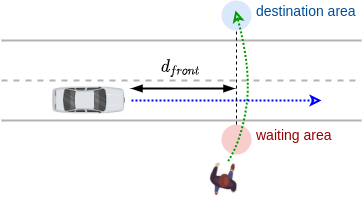[
Date Prev][
Date Next][
Thread Prev][
Thread Next][
Date Index][
Thread Index]
[
List Home]
|
Re: [sumo-user] Modify pedestrian dynamic model
|
Dear Jakob
Here comes the paper: "Vadere: An open-source simulation framework to promote interdisciplinary understanding". In 3.2.3, the guide in this document is honestly very short, but I suppose a well-experienced developer could easily follow it and then write his own model
Thank you for the reference. I very much agree with the goal of simplifying custom pedestrian model integration into SUMO (w.r.t documentation as well as simplicity of API).
With that in mind I'd be very interested in reading the mentioned documentation on how to add custom models to Vadere. Unfortunately, I was not able to find this either in the paper nor on
vadere.org or at
https://gitlab.lrz.de/vadere/vadereCan you provide a link?
Thank you Jakob
By the way, as reading the paper of Vadere [1], I notice that this pedestrian dynamic simulation has a guide for any user-defined model. In this guide, one could know which class is to extend and which methods are to override. It helps Vadere developers a lot. Of course, Vadere is no match for our SUMO (in scope as well as user community) ; but I hope one day SUMO could give its developers such a guide.
==========================================
[1] Reading 3.2.3 of "Vadere: An open-source simulation framework to promote interdisciplinary understanding"
For (ii) you might be able to hack something together with TraCI (person.setSpeed,
https://sumo.dlr.de/docs/TraCI/Change_Person_State.html): whenever an S encounters a D ahead of an intersection you could slow down it's maximum speed to that of D so they will only cross together. After the the intersection you could reset the speed for S.
Thank you, Mr.Jakob
About (ii), yes, my main goal is to get temporary formation of pedestrian groups. Realistic looking visualization is also important but not the main objective.
(iii) if it's impossible to take the length of a platoon into account, I would change a bit in my environment, for example, the platoon has a very small distance between each AGV, then no one could come between two AGVs. Therefore the platoon of several AGVs would become a unique AGV which is long, containing several carriages (each carriage is a single AGV). This long AGV lets pedestrians notice it and the length prolongs waiting time for them. Therefore, due to waiting so long, the gap acceptance of pedestrians will reduce in the near future.
(i) you can define different types of pedestrians (i.e. name S,N,D, etc) and assign different maximum speeds
(ii) complex group behavior as described is quite far from the current models. What is the main goal here?
- accurate travel times for persons (might work by making some persons slower)
- accurate travel times for AGV (might work by making some persons "bigger")
- temporary formation of pedestrian groups that block a bigger part of the floor space (assemble, cross, disperse)?
- realistic looking visualization?
My guess is that the latter two points would be quite involved to model and implement.
regards,
Jakob
Thank you Mr.Jakob
Let me briefly introduce my healthcare environment: individuals move with AGV. The AGVs are only to transfer materials in the environment (a flat floor) like the following picture. AGV might meet pedestrians who include: staff (S for short), visitor (V for short), patients - move like normal (N for short) and individuals with disabilities (D for short)
Therefore I need some improvement:
(i) in XML, the personFlow needs new attributes, for example: disable (a probability indicates the person is D or not). If a pedestrian is D type, he might have a stick or crutch or wheeled-chair or even he is bind.
(ii) In the intersection, D person (who has a slower velocity) might be carried by other S, V or even N people for crossing, especially as the D is moving in a crossway. After leaving the crossway, D person could be left alone.
(iii) A pedestrian will have different gap acceptance (a distance between person to the AGV). If the distance is too short, he/she would decide to stay at the waiting area.
The gap acceptance of a pedestrian depends on yielding of vehicle (too loud or not), healthy of the person as well as the number of AGV's platoon
Looking at the code of Omnet++ and SUMO, I still don't know which files to modify. If it is too difficult to change the code, perhaps I have no choice but to use a quick and dirty hack to get my purpose.
Thank you in advance
Some comments:
- the paper ""Modelling pedestrian dynamics in SUMO" doesn't describe the whole set of vehicle/pedestrian interactions that are currently implemented
Can you describe the interactions that you need to simulation in more detail?
Dear all
As reading the papers: "Modelling pedestrian dynamics in SUMO" and "Pedestrian Simulation In SUMO Through Externally Modelled Agents" I notice that the current pedestrian model in SUMO is very simple.
In my work, I need a pedestrian model which reflects a healthcare environment. In this model, I intend to implement interaction between vehicles (Automated Guided Vehicle) as well as individuals with disabilities
I still don't know how to implement a new pedestrian model in SUMO, could I need to modify the code of Viens?
Does anyone have a hint for me by chance?
Thank you in advance
sumo-user mailing list
sumo-user@xxxxxxxxxxx
To unsubscribe from this list, visit https://www.eclipse.org/mailman/listinfo/sumo-user
sumo-user mailing list
sumo-user@xxxxxxxxxxx
To unsubscribe from this list, visit https://www.eclipse.org/mailman/listinfo/sumo-user
--
sumo-user mailing list
sumo-user@xxxxxxxxxxx
To unsubscribe from this list, visit https://www.eclipse.org/mailman/listinfo/sumo-user
sumo-user mailing list
sumo-user@xxxxxxxxxxx
To unsubscribe from this list, visit https://www.eclipse.org/mailman/listinfo/sumo-user
--
_______________________________________________
sumo-user mailing list
sumo-user@xxxxxxxxxxx
To unsubscribe from this list, visit https://www.eclipse.org/mailman/listinfo/sumo-user
sumo-user mailing list
sumo-user@xxxxxxxxxxx
To unsubscribe from this list, visit https://www.eclipse.org/mailman/listinfo/sumo-user
--
Attachment:
Vadere- An open-source simulation framework to promote interdisciplinary understanding.pdf
Description: Adobe PDF document

